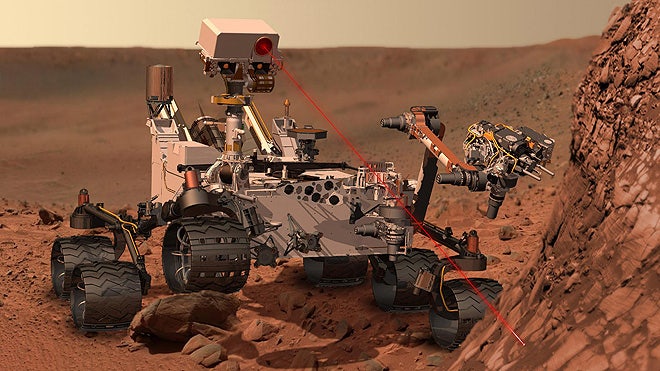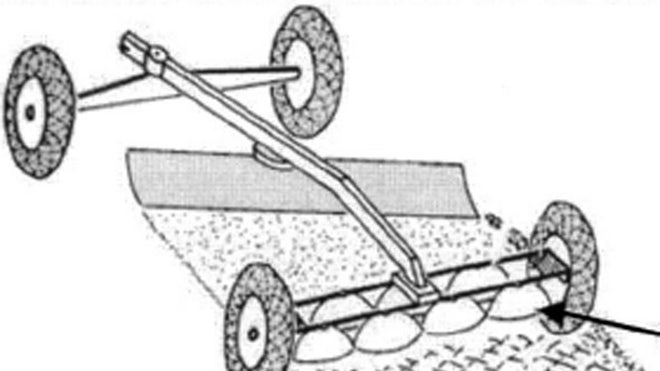If all goes well, a roving science laboratory called Curiosity will land on Mars on August 5th and kick off a two-year scientific mission that could one day lead to a manned trip to the Red Planet.
The six-wheeled, 2,000-pound vehicle is the largest mobile laboratory ever sent by humans to an extraterrestrial body, and is powered by a plutonium fueled radioisotope thermoelectric generator. However, as impressive as that sounds, Curiosity has a top speed of.06 mph and is scheduled to travel just 12 miles across the alien surface.
While that's fine for a pioneering, largely automated endeavor, human explorers might not be so patient or willing to work closely with a radioactive power source. And once there are enough of them up there that we start calling them colonists, the cost of shipping fuel and equipment from Earth will become literally astronomical, which begs the question:
What will Martians drive?
The President of Astrobotic Technology, John Thornton, thinks the answer may first be found on the Moon. His company is building a solar-powered rover that will begin searching for water at our nearest neighbor's north pole in 2015. If it finds any, it would facilitate the establishment of a permanent, self-sustaining manned base that would serve as a test bed for future manned missions to Mars.
Even before there are the thousands of people necessary to support an industrial center on the Moon, so-called 3D printers could be used to build small numbers of vehicles on site using locally-sourced materials through a process known as additive manufacturing. Designs are simply uploaded to a computer which then uses them to manufacture parts from the inside out.
In the low gravity environment, weight won't be as much of an issue as it is on Earth, and vehicles, or at least spare parts for ones sent from Earth, could be built from the iron-rich soil readily available on the surface. Electricity would be the initial power source used, but it could come from a variety of sources.
Thornton says that while small solar panels are ideal for lone, robotic missions, central stations will eventually be needed to supply larger vehicles with much more power than mobile solar cells can provide. This could come in the form of electricity generated by a large solar array used to charge onboard batteries, or a hydrogen and oxygen fill up to run a fuel cell, the gasses produced through the electrolysis of water.
Lawrence Taylor, a planetary geochemist at the University of Tennessee who advised astronauts during the Apollo 17 mission offers another suggestion: methane. He says it could be created from the mix of hydrogen, carbon and nitrogen deposited in the lunar soil by solar winds. Using oxygen produced from water, the methane could be burned just like it is in a natural gas vehicle on Earth.
However, the biggest hurdle may not be how these "cars: drive, but where. Dust kicked up in the low-gravity environment posed many problems for the Apollo astronauts, and the situation will only be worse with lots of Moonlings riding and hopping around.
Read: Goodyear "spring tire" ready for extraterrestrial offroading
Taylor may have the solution for this as well. He and a colleague, Thomas Meek, have conceived a Lunar Road-Paving Wagon that can theoretically melt roads into the surface using a process called microwave sintering, thanks to the unique makeup of the lunar soil. After leveling the soil with a grader on one end of the vehicle, a set of magnetrons on the other would be used to heat up the tiny particles of nanophase iron prevalent in the soil which would then melt glass deposits present to form a packed surface. Using this process, the vehicle could build landing pads, building foundations and the roads that connect them.
Data collected by Curiosity could help determine if this sort of highway construction would also be work on Mars, but other challenges will be faced by the transportation system there. With its distance from the sun and thick, light-blocking atmosphere, Thorton points out that the use of solar power is even less efficient than it is on Earth.
With this in mind, one engineer says the key to success for settlers will be to think like a native and learn to live off the land, and in this case the air.
If we all had been born and raised on Mars, we would think nothing of burning carbon dioxide gas, the Martian atmosphere, says John Wickman, founder of Wyoming-based Wickman Spacecraft and Propulsion. We would be burning it with magnesium powder. Magnesium is available in the Martian soil. Just like we drill for oil and natural gas on earth, we would be mining magnesium and burning it for power and transportation on Mars.
Up until now, Wickman has focused on designing aircraft that use jet and rocket engines that run on the mixture, but he says it could also be used to fuel an internal combustion engine. In fact, he thinks it might work even better in that application because one of the challenges is compressing the carbon dioxide to a high enough pressure to facilitate efficient combustion, and pistons excel at that.
So while it's not clear if General Motors is looking to set up shop on Olympus Mons just yet, the Corvette of the distant future could still have a V8 under the hood.


No comments:
Post a Comment